This holiday season will beat all records.
According to Adobe, which has been monitoring online sales through its Adobe Analytics data troves, 2021 is expected to see record-breaking online holiday sales: $207 billion in the U.S. market and $910 billion globally.
Last year was already an unprecedented year in e-commerce, with a 21% increase year-over-year in online Thanksgiving spending in the U.S. market. But there is still room for growth: another 10% increase is expected this year, according to Adobe. This is more or less in line with eMarketer’s and Deloitte’s projected 11% increase in e-commerce for the same period.
What is even better – all demographic verticals are expressing a marked interest in holiday sales, if the price is right.
Ready? Scroll down to start reading!
Table of contents
Click on any chapter to scroll directly to it.
Chapter 1
What we know about holiday shoppers in 2021
We already know we can expect an increase in online shopping interest this holiday season. After a flurry of businesses turned to selling online to cope with Corona-driven restrictions in brick-and-mortar locations, online shopping has become a much more common experience across the world. What, then, should advertisers pay attention to?
Holiday shopping to increase across demographics
Age
In general, it is being reported that consumers across both age and gender demographics are turning more and more to sales, both online and in-store, for their holiday gift list. Finder reports that 69% of people aged 18-24 are most likely to shop if the price fits. But even in the 65+ demographic, who have historically shown the least interest, over half of the surveyed adults say they would shop sales if the offer struck the right chord.
Gender
Comparable percentages of men and women plan to participate: 59% of the men and 57% of the women surveyed have expressed an interest in shopping the holiday sales, especially if the discount were around 50% of the full retail price.
Online increases vs in-store
44% more shoppers chose online vs in-store shopping in 2020. The trend is expected to slightly increase in 2021, fed by ongoing health concerns, as well as by the improved online shopping experience and better online prices.
What is also extremely important: online ads drive foot traffic. Attribution is still not easy to manage, but studies indicate that seeing an online holiday sale ad is likely to increase foot traffic and in-person sales.
Mobile shopping still big
The pandemic accelerated the adoption of mobile shopping in general. The results of this trend are likely to be spilling over into post-pandemic times as well. In the first half of the year, mobile shopping increased by 30%.
However, while mobile traffic is growing overall, Adobe estimates that 2021 will see holiday shopping on smartphones hitting a plateau. Still, at $86 billion expected spend, that’s still a considerable amount of profit you can target by customizing your ad experience.
Buy Now, Pay Later gains momentum
As a way of having one’s cake and eating it too, the trend of BNPL shopping is expected to increase. 10% more shoppers compared to 2020 and 40% more compared to 2019 are using this option even for small purchases.
The BNPL options cover everything from large electronics to smaller grocery orders.
Brand loyalty gets weaker
According to McKinsey’s findings last year and confirmed across industries and regions, around 40% of shoppers switched brands or retailers.
With over half of last year’s holiday shopping being conducted online, customers have received positive experiences and grown to trust online retailers. This will further drive a willingness to switch brands and retailers.
If not loyalty, then what drives online shopping? Not surprisingly, the main reason for the switch was a better price/value proposition.
Multi- and omnichannel user experience
In 2021, the increase in online selling is all related to a comfortable experience for the user. This includes giving users access to a company’s offering across all channels and devices. A multi-channel retail experience could include, for instance, brick-and-mortar stores, WhatsApp, TikTok, Google Shopping, the company’s own website and more. Omnichannel would include all possible options, whereas multichannel would collect the most relevant or accessible channels in order to reach customers at more touchpoints.
In 2021, omnichannel (the name generically adopted for both types of customer targeting) is the new normal. Customers experience the product in a physical store and then shop online for the cheapest offer; read online reviews and finalize the purchase in a store; order online and pick up in person; and so on.
For optimum results, messages have to be channel-first, not audience-first. There are, for instance, different trends on TikTok vs Instagram, websites vs social media and so on. Needless to say, native ads can work perfectly on their own or in combination with other channels. For example, you can overview the hottest discounts in native editorials or entertain users with quizzes and other interactive content, and then retarget this audience across other platforms using MGID pixels.
When looking for the best-fit communication channels, you have to take into account user demographics, user interactions in these channels and their interests, and ultimately, the cost-efficiency of reaching these audiences.
Start holiday advertising ASAP!
This year, on top of other concerns, e-commerce is challenged above everything by the unprecedented supply chain strain. This is expected to persist into the holiday season and well beyond. With delays forecasted across the world, holiday shoppers must have realistic expectations.
The challenge of these realistic expectations starts from production, where raw materials may also be hit by shortages, and ends in the last-mile delivery. Quick and hassle-free delivery is an e-commerce must that shoppers value above all else. Free delivery and returns are by now not a perk, but an expectation, as evidenced in McKinsey’s report. Early proof: out-of-stock messages have already increased 172% this year to date.
Shoppers are already aware, to a large extent, of the possibility of delays and an estimated 40% have consequently started their holiday shopping early this year. Adobe also estimates that this year’s holiday shopping began in October. If shoppers are ready and retailers are not, there is massive potential for disappointment and profit loss.
How do you stand out in this crowded holiday landscape? Two key factors of a successful holiday marketing strategy are great ad design and originality. However, depending on your category, here are some specific recommendations to catch the eye and loosen the purse strings of your target audience.
Chapter 2
Apparel, outdoor & footwear
The challenge in this category is that there is a lot of competition and, consequently, a lot of customer fatigue around consumer goods of this type. To make the most of the campaigns, here are some recommendations based on thousands of successfully run seasonal campaigns.
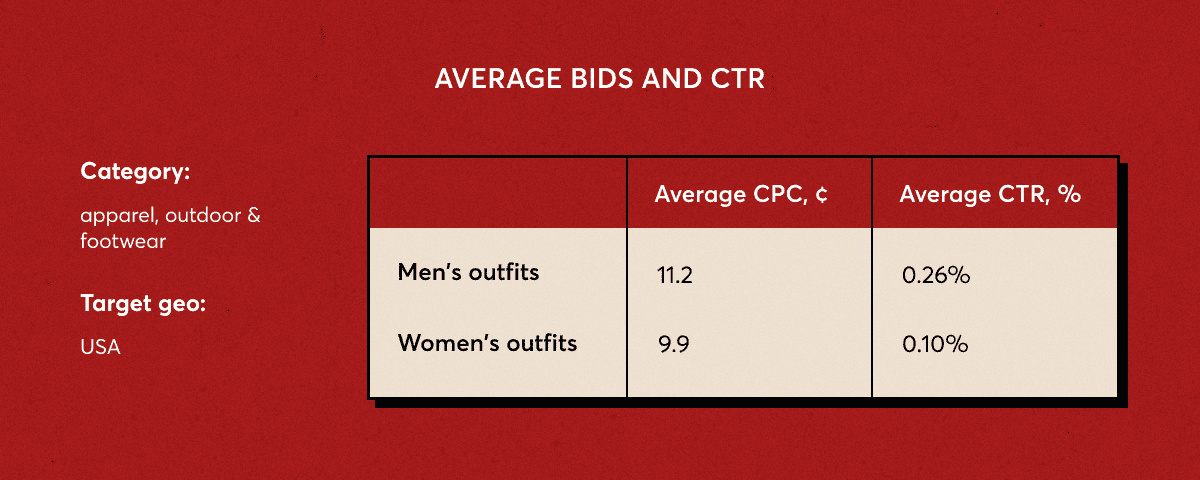
Holiday marketing tips
- Add non-seasonal items that are already on sale. Discount hunters love finding items they can buy for a song.
- Show diversity and move away from stereotypes. Men can wear pink and women can have buzz cuts. Do not forget to show diverse models in your creatives.
- Add season-themed items. Use Christmas-themed items and clothing, for instance, models looking cozy and season-ready.
- Make sure all sizes are available for all items except for discounted leftovers. It may disappoint users when size information is misleading or certain sizes are missing. These users are unlikely to return.

Copy recommendations for creatives and landing pages
- Advertise numbers. Prices and especially discount rates catch the eye and show transparency.
- Offer unusual discounts or specials – such as “The discount % is the size of your t-shirt.”
- Use catchy language. Idioms, puns, slang stir curiosity and help you stand out. Your brand will also be perceived as youthful, trendy, or witty.
- Mention key details such as all sizes available, free delivery, clothes for all body sizes, etc.
- First capture attention, then redirect. Capture your readers’ attention with quizzes, articles, tests – then steer them toward the product that best fits their interests.
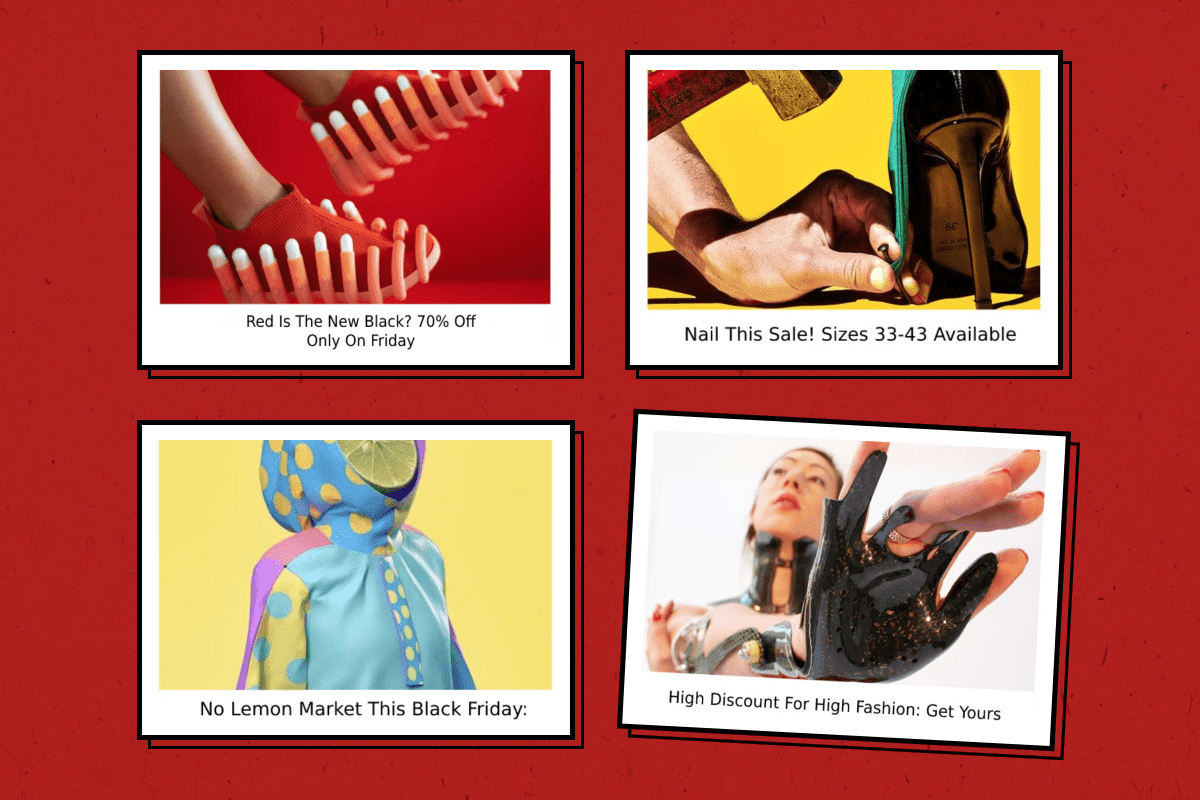
Ideas for creatives and visuals
- One color scheme can work well (e.g., red clothes on a red background).
- Previews instead of full picture. Create thumbnails that show relevant details, but not the full image. Example: Show the item on the model, but not the entire outfit/look. This way, you can build intrigue and lead the reader to click on the image and view the full outfit.
- Unusual mannequins. Use original visuals to stand out: mannequins with the heads of horses, birds or just unusual-looking people. You can also photoshop models’ faces into animal heads or unusual objects: fruits, balloons, gadgets, etc., or you can use virtual models.
- Poses and angles. Standard fashion photoshoots will surprise no one. Stand out with original photography.
- Extraordinary sizes. Giant or miniature clothing items look intriguing. Try combining it with some humor.
- Actions with clothes. Take a popular metaphor and make it literal: Nailing it can be done with a hammer and nail, and thinking outside the box can be done with a literal box.
Success cases with MGID

Chapter 3
Skincare & haircare, makeup, fragrance
In this vertical, you have a wide spectrum of demographics. Where most players try to be extravagant and luxurious with fake glam, you can stand out by matching the tone of your audience and by being practical.

The tips below are tried and true tactics to maximize conversions in a busy category during the busiest season of the year.
Holiday marketing tips
- Select calmer and more natural colors for models. In this niche, ultraviolet makeup colors or fake-glam are passé. Calmer, more natural or realistic colors convey good taste across major customer demographics.
- Strive for uniqueness. Do it with original visuals, imaginative discounts, practicality and smart calls to action.
- Add bonuses like free shipping or 2+1 offers.

Ideas for creatives, visuals, and copies
- Ask questions in your copy. For example, “How much does your favorite perfume cost now?” or “Want a 50% discount on aromatherapy?”
- Match your tone to the audience. For a more conservative audience, use numbers instead of puns.
- Use matching backgrounds. An industrial background for a grunge look, a softly lit background for a casual look, a garden setting for natural products, etc.
- Make the benefit immediately clear. Display the discount, price, or campaign value proposition as the main hook so your audience immediately understands what they stand to gain.
- If advertising beauty gadgets, show them being used. Help users immediately understand how these products will benefit them.
- Use unexpected imagery. Photoshop unexpected elements into your visuals or match the colors of the product with a stunning background.
Success cases with MGID

Chapter 4
Home decor
This category is ripe for the season: discounts make large projects feasible – but small home décor gifts are a classic go-to for gifts all around. For 2021, comfort and color are the keywords.

Holiday marketing tips
- Bank either on vintage pieces or something new and fashionable. Don’t aim for the middle – it can easily look boring.
- Don’t reveal everything. Stores often show a variety of discounted products on the main page. However, for this category, it is better to keep users engaged and clicking through website sections. Choose unique and unusual items to show on the home page.
- Women purchase home decor more often than men. Male shoppers, however, are more responsive to interactive elements like quizzes or room design builders.

Copy recommendations for creatives and landing pages
- Play with the audience. For example, you can ask them to guess the most expensive lamp in the picture or the vase with the biggest discount.
- Mock-reproachful questions can engage the audience: “How come you haven’t seen our prices yet?” or “Why don’t you like discounts?”
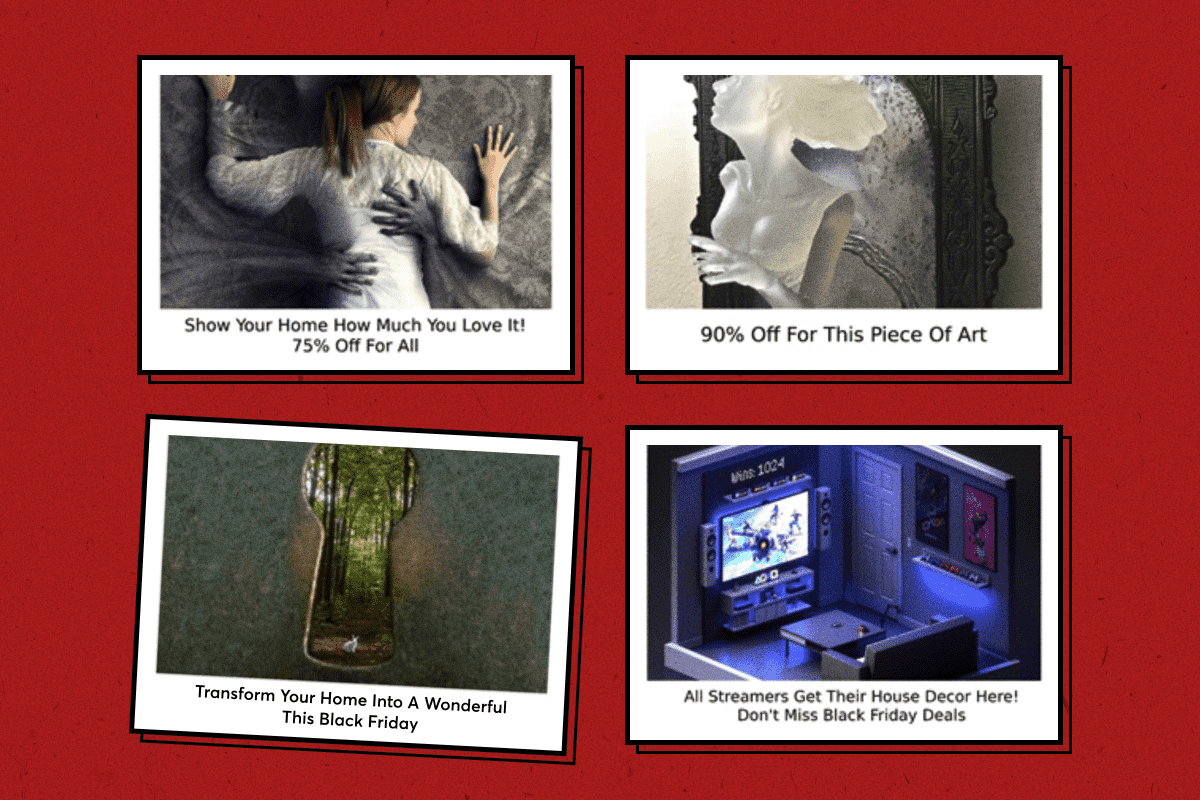
Ideas for creatives and visuals
- The color scheme matters. Bland is not a color: forget the gray and blue scheme of the page layout and go for vibrant combinations: purple and orange, burgundy and yellow, baby blue and magenta.
- Capture attention, then lead on. The hardest part is getting the audience’s attention. Human interest stories, what not to do, glamour on a budget and other inviting topics capture attention – then just guide the visitor across pages.
- For creatives and other visuals: try tridimensional or contextual imagery. Dioramas or 3D photos are an equally good choice.
- Original imagery that suggests comfort or, depending on your audience, boldness.
- For creatives and other visuals: sneak peeks through keyholes or doorways into newly designed rooms.
- Only for creatives: cluttered images with similar items. A user would want to put things in order or declutter the space and end up clicking on the ad.
- Discounts on popular items. An all-time classic approach of combining discount rates with popular decor items on photos can also work well.
- Call out a specific audience: Attention all gamers, Busy mothers deserve a break, etc.
Success cases with MGID

Chapter 5
Food & beverage
We eat with our eyes. For this vertical, there are two main commandments: make it appetizing and make it easy. Drinks and food alike should invite cravings. Once that feeling is there, your audience should be able to take action immediately and hassle-free.
Holiday marketing tips
- Bright, juicy color schemes make the product look fresh and inviting.
- Use photos of scattered or unusual food that still looks appetizing: a user instinctively regrets fresh tasty food that is wasted. In addition, food that is not perfect will seem more accessible.
- If you use photos of people, make sure that user attention does not stray from the product to the human models.
- Make it easy. Food shopping is often impulse-driven. You should make it easy for your audience to immediately understand and act. Easy to order or easy to download are rules of thumb in this vertical.
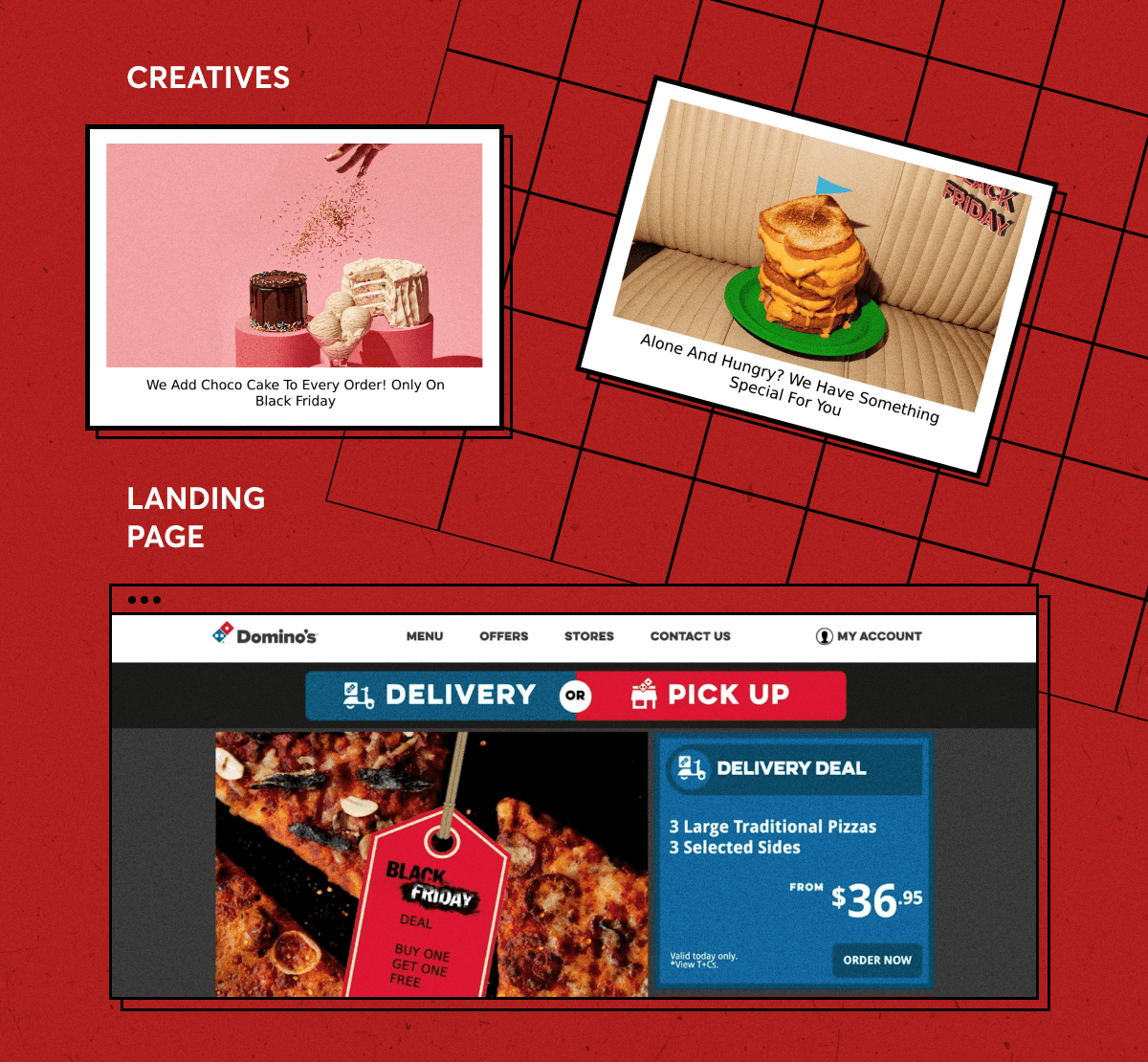
Copy recommendations for creatives and landing pages
- Invite the feeling. Ask a user if they are hungry, if they recall the taste of a cold freshly opened beverage or if they can imagine the texture of a certain food.
- Tout a special offer. Oldies are goldies for a reason: they still work. All variants welcome: 3 for 1, dessert for every order, extreme discounts, etc.
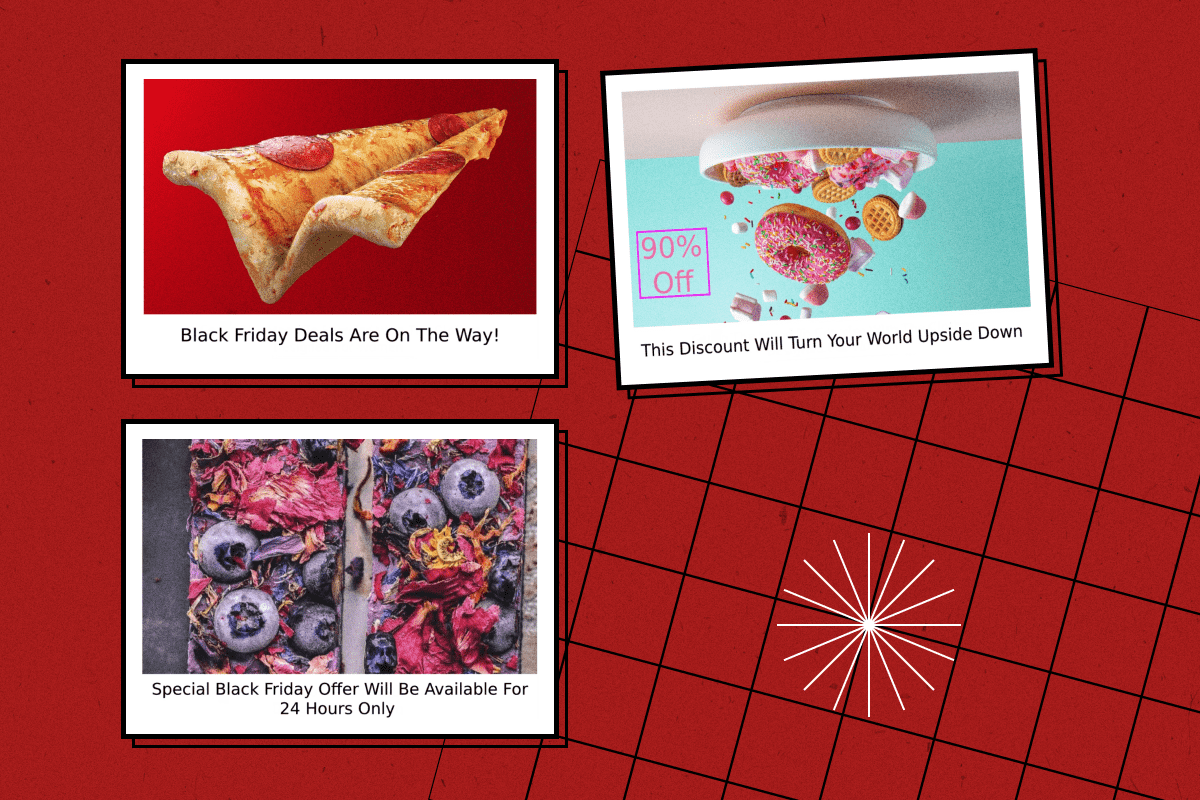
Ideas for visuals
- Clustered images with similar items that make users look for differences.
- Countdown and limited time offers. Scarcity works in all categories, but during the holidays, people are not only buying more feverishly but also more inclined to buy if they see special offers.
- Dynamic photos. For example, food falling out of a plate, sauce dripping off a sandwich, steaming hot drinks, etc.
- Don’t be afraid to go beyond the common representation, stand out with something unexpected yet appealing. The only risk is the audience may not associate feelings of hunger with unfamiliar, uncommon food concepts.
Success cases with MGID

Chapter 6
Wearable technology & gadgets
People crave novelty gadgets all year long; during the holiday sales season, it is finally time to indulge. The keywords of the day: accessible and desirable.

Holiday marketing tips
- Focus on either the latest, newest models on everyone’s wish list - or opt for something unusual.
- In your creatives, show gadgets with accessories and make them look even funkier, friendlier, or more stylish.
- To capture user attention, you can use miniaturized or gigantic gadgets in your photos.
- Retargeting is king. For a category where prices are relatively high, investments are long-term and purchases are not impulse-driven, it makes sense to retarget your prospects and remind them of your special offer.
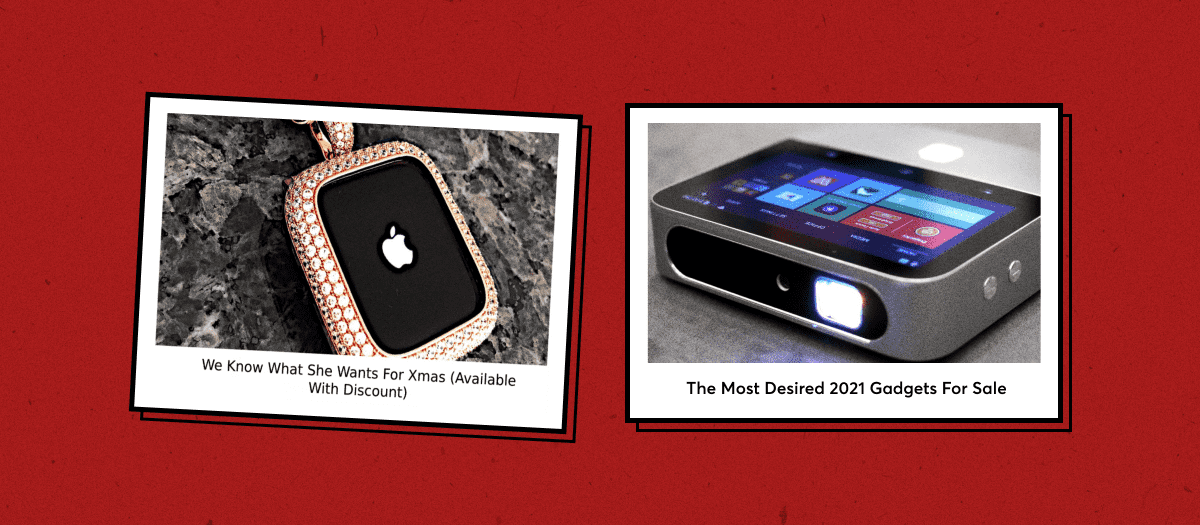
Copy recommendations for creatives and landing pages
- Be specific. Add discount figures or old price/new price to your product photos.
- Wearable gadgets are perfect Christmas gifts. In copies, you can stress that it’s exactly what our dearest ones want.
- Lists are very clickable. Create an overview of the best gadgets in 2021, most wished-for gadgets of the season, etc., and add links and discounts to the article.
- Sell the benefit, not the product. In your copy, tout the advantages of the advertised product and what they can change for a user in their daily life. For example, get 3x more likes on Instagram with this camera.

Ideas for creatives and visuals
- Combine incompatible things, for example, a gadget and thick golden chain to stir curiosity.
- Incorporate pets in visuals to show how easy it is to use the technology (and to capture sympathy!).
- Futuristic glamour. Photos with the red and blue 3D effect, futuristic photos and Sci-fi-themed imagery immediately convey the idea of the latest innovation and trendiness.
Success cases with MGID

Chapter 7
Unwrapping it up
For the festive season, companies go all-out on advertising. Make sure your holiday sale campaigns look good next to the other players in your arena by incorporating at least some of these tried-and-true tips:
- Create a special navigation button for your Black Friday/ Cyber Monday/ Christmas/ Holiday sale and add the button to all pages on the site.
- Don’t make users wait — offer same-day shipping or other delivery benefits. Free delivery is a given!
- Go for the feeling. Appeal to the emotional side of shoppers — remember that this can differ by vertical. Some people want snuggly slippers for Christmas, while others want shiny red shoes.
- Retarget, especially for more expensive items. Give shoppers time to get accustomed to the idea and the price bracket. Offer even bigger discounts in retargeting ads.
- Offer a great customer experience. Products and benefits should be easy to understand, holiday shopping ads easy to click on, and landing pages easy to navigate through, from the home page to the Buy button.
Total holiday sales are expected to hit the $1 trillion mark this year. With one-fifth of this amount going to online shopping and a large portion of the rest also impacted by online ads, advertisers have a goose all ready to lay golden eggs in 2021. With the recommendations in this guide, you can fine-tune your pay-per-click tactics to get momentum in your niche and move your business forward.





